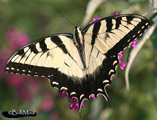Native Plants
Search for native plants by scientific name, common name or family. If you are not sure what you are looking for, try the Combination Search or our Recommended Species lists.
Populus tremuloides
Populus tremuloides Michx.
Quaking Aspen, Golden Aspen, Trembling Aspen, Mountain Aspen, Aspen, Trembling Poplar, Alamo Blanco
Salicaceae (Willow Family)
Synonym(s): Populus aurea, Populus cercidiphylla, Populus tremula ssp. tremuloides, Populus tremuloides var. aurea, Populus tremuloides var. cercidiphylla, Populus tremuloides var. intermedia, Populus tremuloides var. magnifica, Populus tremuloides var. rhomboidea, Populus tremuloides var. vancouveriana, Populus vancouveriana, Populus ×polygonifolia
USDA Symbol: POTR5
USDA Native Status: L48 (N), AK (N), CAN (N), SPM (N)
A 35-50 ft., sometimes taller, deciduous tree, quaking aspen is pyramidal when young, usually developing a long trunk and narrow, rounded crown at maturity. Its small, nearly round, shiny leaves have a flattened petiole which allows them to quiver in the slightest breeze. Smooth, whitish-green bark becomes furrowed at the trunk’s base with age. Silvery catkins appear before leaves. Fall color is bright yellow.
The names refer to the leaves, which in the slightest breeze tremble on their flattened leafstalks. The soft smooth bark is sometimes marked by bear claws. A pioneer tree after fires and logging and on abandoned fields, it is short-lived and replaced by conifers. Sometimes planted as an ornamental. Principal uses of the wood include pulpwood, boxes, furniture parts, matches, excelsior, and particle-board. The twigs and foliage are browsed by deer, elk, and moose, also by sheep and goats. Beavers, rabbits, and other mammals eat the bark, foliage, and buds, and grouse and quail feed on the winter buds.
Plant Characteristics
Duration: PerennialHabit: Tree
Leaf Retention: Deciduous
Leaf Arrangement: Alternate
Leaf Complexity: Simple
Breeding System: Flowers Unisexual , Monoecious
Fruit Type: Capsule
Size Notes: Up to about 100 feet tall, often shorter. Trunk to about 3 feet in diameter
Leaf: Green
Autumn Foliage: yes
Fruit: Brown
Bloom Information
Bloom Color: Yellow , Green , BrownBloom Time: Mar , Apr , May , Jun
Distribution
USA: AK , AR , AZ , CA , CO , CT , IA , ID , IL , IN , MA , MD , ME , MI , MN , MO , MT , NC , ND , NE , NH , NJ , NM , NV , NY , OH , OR , PA , RI , SD , TX , UT , VA , VT , WA , WI , WV , WYCanada: AB , BC , MB , NB , NL , NS , NT , NU , ON , PE , QC , SK , YT
Native Distribution: In cooler areas and mountains almost throughout North America, from Alaska and Labrador in the north through all major mountain chains in the US to mtns of Mexico as far south as Puebla in central Mexico
Native Habitat: Stream banks; moist, low areas; moist, upland woods; disturbed areas
Growing Conditions
Water Use: HighLight Requirement: Sun , Part Shade , Shade
Soil Moisture: Dry , Moist , Wet
CaCO3 Tolerance: High
Drought Tolerance: High
Cold Tolerant: yes
Soil Description: Igneous, Limestone-based, Sandy, Sandy Loam, Medium Loam, Caliche type, Shallow, moist, rocky , sandy to fine clay soils.
Conditions Comments: Quaking aspen reproduces rapidly from seed and root suckers. It is short-lived and plagued by disease and insect problems, but is practically indifferent to soil conditions. In any soil, weeding around the tree can boost its growth surprisingly. Aspen can be grown in a clump by periodically removing the older, damaged stems, allowing new sprouts to fill in. Western material is often referred to as var. aurea.
Benefit
Use Ornamental: Attractive, Fall conspicuousUse Wildlife: Aspens are host to a wide array of birds, mammals, and butterflies. Seeds-granivorous birds, Browse
Attracts: Birds , Butterflies
Larval Host: Eastern Tiger Swallowtail, Viceroy
Butterflies and Moths of North America (BAMONA)
|
Great ash sphinx (Sphinx chersis)  Adult Food Source |
Eastern Tiger Swallowtail (Papilio glaucus)  Larval Host |
Viceroy (Limenitis archippus)  Larval Host |
Propagation
Propagation Material: Root DivisionDescription: Easy to propagate from suckers or cuttings, though when available, fresh seeds germinate readily in high percentages. Fresh seed is viable only a few days. Seeds should not be covered and seedbed should be kept saturated the first month.
Seed Treatment: No treatment is necessary.
Commercially Avail: yes
Find Seed or Plants
Find seed sources for this species at the Native Seed Network.
View propagation protocol from Native Plants Network.
National Wetland Indicator Status
| Region: | AGCP | AK | AW | CB | EMP | GP | HI | MW | NCNE | WMVE |
| Status: | FAC | FACU | FACU | FAC | FAC | FAC | FACU | FACU |
From the National Organizations Directory
According to the species list provided by Affiliate Organizations, this plant is on display at the following locations:Native Seed Network - Corvallis, OR
Bibliography
Bibref 1186 - Field Guide to Moths of Eastern North America (2005) Covell, C.V., Jr.Bibref 298 - Field Guide to Texas Trees (1999) Simpson, B.J.
Bibref 1185 - Field Guide to Western Butterflies (Peterson Field Guides) (1999) Opler, P.A. and A.B. Wright
Bibref 946 - Gardening with Prairie Plants: How to Create Beautiful Native Landscapes (2002) Wasowski, Sally
Bibref 355 - Landscaping with Native Plants of Texas and the Southwest (1991) Miller, G. O.
Bibref 841 - Native Alternatives to Invasive Plants (2006) Burrell, C. C.
Bibref 291 - Texas Wildscapes: Gardening for Wildlife (1999) Damude, N. & K.C. Bender
Search More Titles in Bibliography
Web Reference
Webref 3 - Flora of North America (2014) Missouri Botanical Garden, St. Louis, MO & Harvard University Herbaria, Cambridge, MA.Additional resources
USDA: Find Populus tremuloides in USDA PlantsFNA: Find Populus tremuloides in the Flora of North America (if available)
Google: Search Google for Populus tremuloides
Metadata
Record Modified: 2022-09-23Research By: TWC Staff